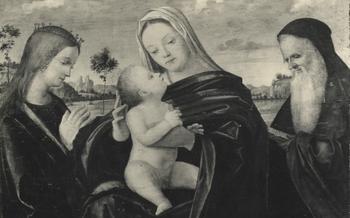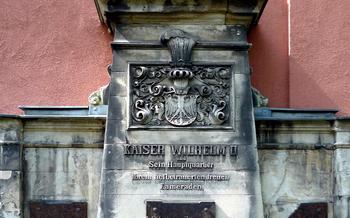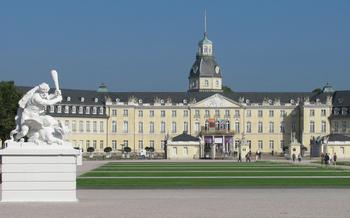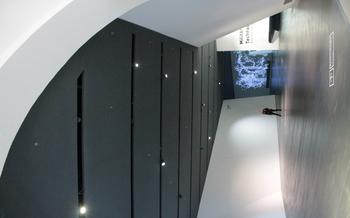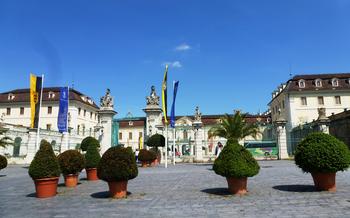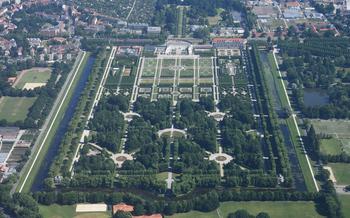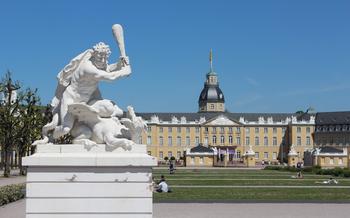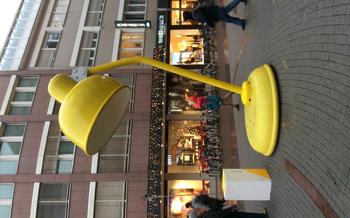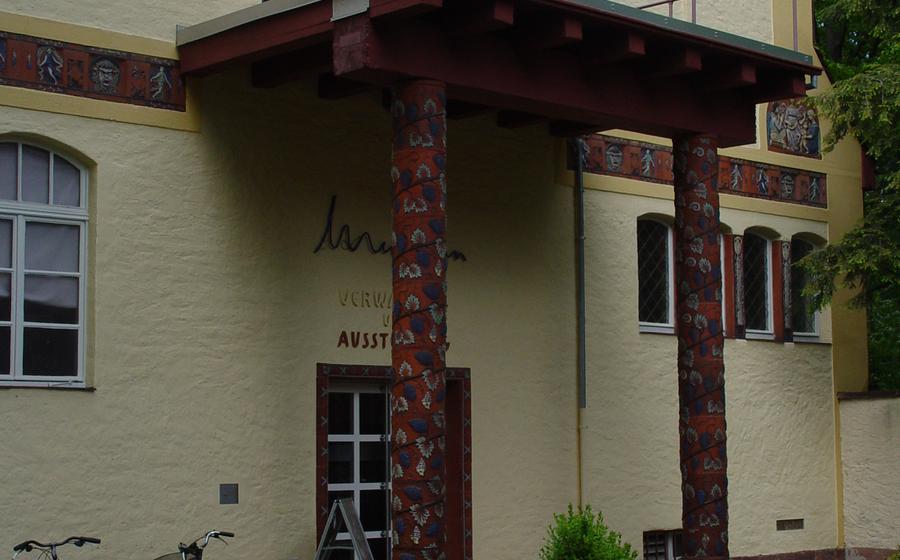
Karlsruhe Majolika
- Karlsruhe Majolika: An Overview
- Historical Significance
- Production Process
- Artistic Styles and Designs
- Product Range
- World Wars and the Manufactory
- Contemporary Majolika
- Majolika Museum
- Guided Tours
- Workshops and Classes
- Gift Shop
- Events and Exhibitions
- Accessibility
- Photography and Videography
- Insider Tip:
Karlsruhe Majolika: An Overview
Karlsruhe Majolika, renowned for its exquisite pottery and artistic designs, holds a significant place in the cultural heritage of Germany. The manufactory, established in 1899 under the patronage of the Grand Duke of Baden, played a pivotal role in the development of the Art Nouveau movement in Germany. Located in the heart of Karlsruhe, the Majolika Museum showcases the rich history, unique production process, and stunning artistic styles of Majolika pottery. Visitors can explore the museum's diverse collection, which includes decorative vases, dinnerware, tiles, and limited edition pieces, gaining insights into the artistry and craftsmanship that have made Karlsruhe Majolika a celebrated name worldwide. Guided tours provide an in-depth understanding of the Majolika tradition, while workshops and classes offer hands-on experiences for those who wish to delve deeper into the art of Majolika.
Historical Significance
The origins of Majolika pottery in Karlsruhe can be traced back to the late 19th century when the Grand Duke of Baden, Friedrich I, sought to establish a ceramics factory in the city. With the support of the Grand Duke, the Karlsruhe Majolika Manufactory was founded in 1899, employing skilled artisans who produced exquisite pottery using traditional techniques.
The Art Nouveau movement, which emphasized organic forms and natural motifs, had a significant influence on the development of Majolika pottery. Artists and designers associated with the movement, such as Max Laeuger and Wilhelm Süs, collaborated with the manufactory to create unique and innovative Majolika pieces that showcased the movement's distinctive style.
Among the notable artists and designers who contributed to the success of the Karlsruhe Majolika Manufactory were Hermann Billing, Ludwig Habich, and Otto Lindig. Billing was a prominent sculptor and ceramicist who designed numerous vases, urns, and other decorative pieces for the manufactory. Habich, a painter and designer, created intricate floral and botanical motifs that adorned many Majolika pieces. Lindig, a sculptor and ceramist, was known for his expressive and whimsical animal figures.
These artists and designers played a crucial role in shaping the unique identity of Karlsruhe Majolika pottery, which became renowned for its artistic excellence and technical proficiency. The manufactory's reputation grew both nationally and internationally, and its products were exhibited at major exhibitions, including the World's Fair in Paris in 1900.
Production Process
The Majolika production process is a complex and meticulous one that involves several intricate steps. It begins with the preparation of the clay, which is sourced from local quarries and carefully selected for its purity and consistency. The clay is then mixed with water and other natural ingredients, such as quartz and feldspar, to create a smooth and workable paste. This paste is then shaped into the desired form using a variety of techniques, including hand-molding, wheel-throwing, and casting.
Once the pieces have been formed, they are left to dry slowly to prevent cracking. This process can take several days or even weeks, depending on the size and thickness of the pieces. Once the pieces are completely dry, they are fired in a kiln at a high temperature, typically between 1200 and 1300 degrees Celsius. This firing process vitrifies the clay, making it hard and durable.
After firing, the pieces are glazed with a special glaze made from a mixture of minerals and metal oxides. The glaze is applied by hand using a brush or by dipping the pieces into a glaze bath. The pieces are then fired again at a lower temperature to melt the glaze and create a smooth, glossy finish.
The final step in the process is to decorate the pieces. This is done by hand using a variety of techniques, including painting, stenciling, and gilding. The pieces are then fired one last time to fix the decoration and ensure its durability.
Artistic Styles and Designs
The Majolika pottery produced in Karlsruhe showcases a diverse range of artistic styles and designs, reflecting the influence of various art movements and the creativity of the artists involved.
Floral and Naturalistic Motifs
One prominent style in Majolika pottery is the use of floral and naturalistic motifs. These designs often feature intricate depictions of flowers, leaves, and other elements from nature, rendered in vibrant colors and lifelike detail. The natural world served as a rich source of inspiration for Majolika artists, who captured the beauty and diversity of the plant kingdom in their ceramic creations.
Geometric and Abstract Designs
In contrast to the naturalistic style, Majolika pottery also incorporates geometric and abstract designs. These patterns are characterized by clean lines, sharp angles, and bold colors, creating a striking visual impact. The influence of Art Nouveau and other contemporary art movements can be seen in these geometric designs, which bring a modern and avant-garde aesthetic to Majolika pottery.
Contemporary Influences
In recent years, Majolika pottery has continued to evolve, incorporating elements from contemporary art and design. Contemporary Majolika artists experiment with new techniques, materials, and forms, pushing the boundaries of the traditional craft. The result is a diverse and dynamic range of Majolika pottery that reflects the artistic sensibilities of the 21st century.
Product Range
Karlsruhe Majolika boasts a diverse range of products that cater to various tastes and preferences. Decorative vases and urns are among the most popular items, showcasing intricate designs and vibrant colors. These elegant pieces are perfect for adding a touch of sophistication to any room. Dinnerware sets, featuring plates, bowls, and cups, are also highly sought after, offering a unique dining experience with their artistic motifs.
In addition, Karlsruhe Majolika produces a variety of other household items, such as tiles, lamps, and clocks, each adorned with distinctive Majolika designs. These items not only serve a functional purpose but also add an artistic flair to any living space. Limited edition and commemorative pieces are also created, often featuring collaborations with renowned artists and designers. These exclusive items are highly prized by collectors and enthusiasts of Majolika pottery.
World Wars and the Manufactory
The outbreak of World War I in 1914 had a profound impact on the Karlsruhe Majolika manufactory. The war disrupted supply chains, conscripted skilled workers, and reduced demand for luxury goods. As a result, production at the manufactory slowed down considerably. However, the factory managed to survive the war and resumed full production after the armistice in 191
The interwar period was a time of resurgence for Majolika. The factory expanded its product range and introduced new designs that reflected the Art Deco style. The manufactory also began to export its products to other countries, including the United States and Great Britain.
World War II once again posed a major challenge to the Karlsruhe Majolika manufactory. The factory was bombed several times during the war, and production was severely disrupted. Despite the challenges, the factory managed to keep operating throughout the war, albeit at a reduced capacity.
After the war, the manufactory underwent a period of reconstruction and revival. The factory was rebuilt, and production was gradually resumed. In the 1950s and 1960s, Majolika pottery once again became popular, and the factory experienced a period of growth and prosperity.
Contemporary Majolika
The Majolika Manufactory continues to thrive in the modern era, blending traditional techniques with contemporary design sensibilities. The use of modern technology has streamlined the production process, allowing for greater efficiency and precision. Contemporary artists and designers have embraced Majolika as a medium for their creative expression, pushing the boundaries of traditional designs. The result is a diverse range of Majolika pieces that reflect the evolving tastes and styles of the 21st century.
One of the key figures in the contemporary Majolika movement is designer and artist Andrea Töpper. Töpper's work is characterized by its bold colors, geometric patterns, and unconventional forms. She has collaborated with the Majolika Manufactory to create a series of limited-edition pieces that showcase her unique style. Another notable contemporary Majolika artist is Christiane Schauder. Schauder's work is inspired by nature and often features intricate floral and animal motifs. Her pieces are known for their delicate craftsmanship and attention to detail.
The Majolika Manufactory has also embraced sustainability as a core principle. The company uses environmentally friendly materials and processes, minimizing its impact on the environment. This commitment to sustainability ensures that the Majolika tradition can continue for generations to come.
Majolika Museum
The Majolika Museum, located in the heart of Karlsruhe, is a treasure trove of Majolika artifacts and history. Established in 1981, the museum showcases the rich heritage and evolution of Majolika pottery through its extensive collection. Visitors can delve into the world of Majolika and explore the diverse range of products, artistic styles, and techniques that have shaped this unique art form.
Displays in the museum include historical pieces from the early days of the manufactory, Art Nouveau masterpieces, and contemporary creations, providing a comprehensive overview of Majolika's journey through time. Interactive exhibits and educational programs engage visitors, allowing them to learn about the production process, glaze techniques, and the influence of various art movements on Majolika. The museum also features a research library and archive, offering a wealth of information for scholars and enthusiasts alike.
Guided Tours
The Majolika Museum offers guided tours that provide an immersive and informative experience for visitors. These tours are led by knowledgeable guides who share insights into the history, production process, and artistic significance of Majolika pottery. Guided tours are available in various languages, including English, German, and French, to accommodate international visitors.
The duration of a guided tour typically ranges from 45 to 60 minutes, allowing ample time to explore the museum's exhibits and learn about the unique characteristics of Majolika. The cost of a guided tour is generally included in the museum's admission fee, providing excellent value for visitors.
To ensure a personalized and engaging experience, advance booking for guided tours is recommended. This can be done through the museum's website or by contacting the museum directly. Alternatively, visitors can opt for walk-in tours, subject to availability.
During the guided tour, visitors will be taken through the different sections of the museum, where they can admire exquisite examples of Majolika pottery from various periods. The guide will provide detailed explanations of the production techniques, artistic styles, and historical context of the exhibits. Visitors will also have the opportunity to ask questions and gain a deeper understanding of Majolika's significance in the world of ceramics.
Workshops and Classes
The Majolika Museum offers a unique opportunity for visitors to learn about and experience the art of Majolika firsthand through workshops and classes. These workshops provide hands-on experience in creating Majolika pieces, allowing participants to immerse themselves in the process and create their own unique works of art.
The workshops are suitable for individuals of all skill levels, from beginners to experienced artists. They cover various aspects of Majolika making, including clay preparation, glazing techniques, and firing. Participants are guided by experienced instructors who provide step-by-step instructions and assistance throughout the process.
Classes are typically held in small groups, ensuring that each participant receives personalized attention and guidance. The museum also offers customized workshops for groups, schools, and corporate events. These workshops can be tailored to specific interests and skill levels, making them an excellent team-building activity or educational experience.
In addition to the practical experience, the workshops also provide insights into the history, techniques, and significance of Majolika pottery. Participants learn about the unique characteristics of Majolika, its role in the Art Nouveau movement, and its cultural and artistic value.
The workshops are a fantastic way to engage with the art of Majolika actively, learn new skills, and create lasting memories. Whether you are a beginner interested in trying something new or an experienced artist looking to expand your knowledge, the Majolika Museum's workshops offer a rewarding and enriching experience.
Gift Shop
The Majolika Museum in Karlsruhe features a well-stocked gift shop, providing visitors with the opportunity to purchase a piece of Majolika history as a souvenir or gift. The shop offers a diverse selection of items, including replicas of historical Majolika pieces, contemporary Majolika creations, and various Majolika-inspired merchandise. Visitors can find decorative vases, plates, tiles, and figurines, as well as magnets, postcards, and other souvenirs. The gift shop also features a selection of books and publications related to Majolika, allowing visitors to delve deeper into the history and techniques of this unique art form. Whether looking for a special gift for a loved one or a memento of their visit to the museum, the Majolika Museum gift shop offers something for everyone.
Events and Exhibitions
The Majolika Museum is a hub for cultural events and exhibitions that delve into the world of Majolika pottery. Temporary exhibitions showcase the works of contemporary Majolika artists, highlighting innovative designs and techniques. These exhibitions provide a platform for emerging artists to showcase their talent and offer visitors a glimpse into the evolution of Majolika in the modern era.
Workshops, lectures, and demonstrations related to Majolika are regularly organized at the museum. These events provide an opportunity for visitors to learn about the history, techniques, and significance of Majolika pottery. Hands-on workshops allow participants to create their own Majolika pieces under the guidance of experienced instructors, making for a memorable and enriching experience.
During the holiday season, the Majolika Museum hosts special events that celebrate the festive spirit. These events may include themed exhibitions, Christmas markets, and workshops centered around creating holiday-inspired Majolika ornaments and gifts. These events are a delightful way to experience the magic of the season while immersing oneself in the world of Majolika.
Accessibility
The Majolika Museum is committed to providing an inclusive and accessible experience for all visitors. Wheelchair users and individuals with limited mobility can easily navigate the museum's galleries and workshops. The museum also offers audio guides and visual aids for visitors with hearing or visual impairments. Visitors with special needs can request assistance from the museum staff, who are trained to provide support and guidance. The museum's website provides detailed information on accessibility features and services, ensuring that everyone can fully enjoy and appreciate the Majolika collection.
Photography and Videography
Photography and videography are generally permitted within the Majolika Museum, but there are certain guidelines and restrictions to be followed:
- Designated Areas: Visitors are allowed to take photographs and videos for personal use only, and only in designated areas of the museum. These areas are typically marked with signs or can be confirmed with the museum staff.
Flash Photography and Tripods:
- Flash photography is not permitted in the museum, as the bright light can damage the delicate Majolika pottery. Tripods are also not allowed, as they can obstruct other visitors and create a safety hazard.
Copyright and Usage Rights:
- All images and videos taken in the museum are subject to copyright laws. The museum holds the copyright to all official images and videos taken on its premises. Visitors who share images or videos online must credit the Majolika Museum and obtain permission for commercial use.
Tips for Capturing the Best Photos:
-
Natural Light: Utilize natural light from the windows to capture the vibrant colors and details of the Majolika pottery.
-
Composition: Experiment with different angles and perspectives to create interesting and visually appealing compositions.
-
Close-ups: Take close-up shots to showcase the intricate details and craftsmanship of the Majolika pieces.
Insider Tip:
To fully appreciate the beauty of Majolika pottery, plan your visit during the early morning or late afternoon to avoid crowds and capture the best natural light for photography. Combine your visit with a stroll through the picturesque Karlsruhe Botanical Garden, located just opposite the museum, for a delightful and immersive experience. For a memorable souvenir, consider purchasing a Majolika piece from the museum's gift shop. Take your time to explore the intricate details and vibrant colors of each item, and choose a piece that resonates with you. Whether it's a decorative vase, a delicate figurine, or a set of tableware, your Majolika souvenir will serve as a cherished reminder of your visit to Karlsruhe.
